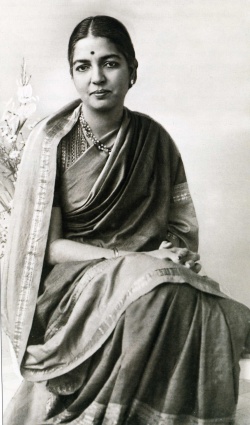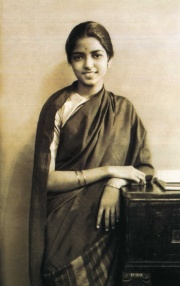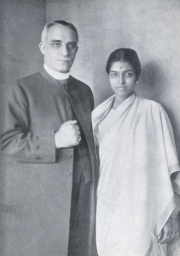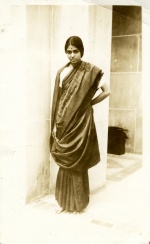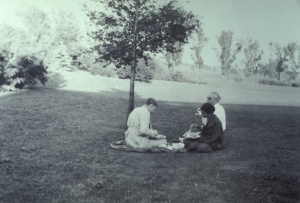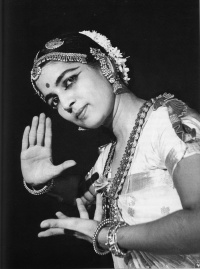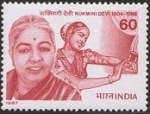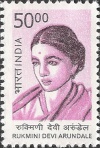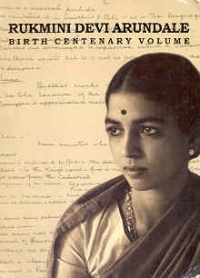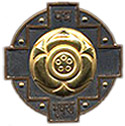Rukmini Devi Arundale: Difference between revisions
| Line 32: | Line 32: | ||
Rukmini joined the Society shortly after her marriage, in June, 1920. In 1923, she became the President of the All India Federation of Young Theosophists, and in 1925 the President of the World Federation of Young Theosophists. | Rukmini joined the Society shortly after her marriage, in June, 1920. In 1923, she became the President of the All India Federation of Young Theosophists, and in 1925 the President of the World Federation of Young Theosophists. | ||
As wife of George Arundale, Rukmini Devi would have been notable in the Theosophical Society even if she had not been such a strong and unique person in her own right. She accompanied her husband on many of his lecture tours around the world, and was acclaimed as a speaker and dancer everywhere. Dr. Arundale assumed the Presidency in 1933, and continued in this role until his death in 1945. Rukmini was only 39 years old when he died. They had shared an interest in young people and education. | As wife of George Arundale, Rukmini Devi would have been notable in the Theosophical Society even if she had not been such a strong and unique person in her own right. She accompanied her husband on many of his lecture tours around the world, and was acclaimed as a speaker and dancer everywhere. | ||
The Arundales became involved with the International Theosophical Centre in Naarden, The Netherlands: | |||
<blockquote> | |||
In 1930, Dr. Arundale became the Head of the <nowiki>[</nowiki>International Theosophical<nowiki>]</nowiki> Centre at [[International Theosophical Centre, Naarden|Naarden]] in the Netherlands, and remained so until 1934, when he became President of the Theosophical Society. Rukmini Devi succeeded him and was the Head of the Centre till she passed away in 1986. Although her chief activities were in India inthe fields of art, education and animal welfare, she visited the Centre as often as she could, which was usually once a year. Rukmini Devi always took a broad view of theosophy in which the arts, animal welfare and vegetarianism were integrated in theosophy. | |||
</blockquote><ref>Shakuntala Ramani, ed., ''Rukmini Devi Arundale: Birth Centenary Commemorative Volume (Chennai, India: The Kalakshetra Foundation, 2003), 189.</ref> | |||
Dr. Arundale assumed the Presidency in 1933, and continued in this role until his death in 1945. Rukmini was only 39 years old when he died. They had shared an interest in young people and education. | |||
<br> | <br> | ||
<br> | <br> | ||
Revision as of 19:11, 16 April 2012
Early years
Rukmini Devi was born on February 29, 1904, into a Brahmin family in the city of Madurai, South India. Her father, Sr, A. Nilakanta Sastri of Thiruvisanellur, was an engineer and a respected Sanskrit scholar. His wife, Srimati Seshammal,came from a very cultured family of Thiruvaiyar.[1] They were "strongly influenced by theosophical ideas to which they had been introduced in 1901. When her father retired, he settled in Chennai close to the headquarters of the Theosophical Society.” [2]
Marriage
On April 27, 1920 the 16-year-old girl married Dr. George S. Arundale, a 44-year-old Englishman who was a Theosophist prominent in Indian education at Central Hindu College. Rukmini wrote of her husband,
He had a striking personality and had a wonderful sense of humour. He used to come home often and mother developed a great affection for him and would feed him Indian pickles and curries! Dr. Arundale was very handsome and was always surrounded by a group of admirers. He would joke and laugh at everything and I think this was what appealed to my own fun loving temperament. He became so much part of our household that my mother used to call him her Krishna to whom she was a Yasoda. So she did not oppose very strongly when Dr. Arundale proposed marriage. She knew enough about the society and the attitude of her own family whom she knew would be totally against it but she did give her blessings and I did not need anything more. Father had passed away but our links with the Theosophical Society was so strong that my mother sought only the advice of Dr. Besant for whom she had a great reverence.[3]
The ceremony was conducted by Alladi Mahadeva Shastri.[4] Rukmini and her family were ostracized by their Brahmin associates, but with support of Theosophists, the Indian public eventually adjusted to the marriage.
Theosophical Society
Rukmini joined the Society shortly after her marriage, in June, 1920. In 1923, she became the President of the All India Federation of Young Theosophists, and in 1925 the President of the World Federation of Young Theosophists.
As wife of George Arundale, Rukmini Devi would have been notable in the Theosophical Society even if she had not been such a strong and unique person in her own right. She accompanied her husband on many of his lecture tours around the world, and was acclaimed as a speaker and dancer everywhere.
The Arundales became involved with the International Theosophical Centre in Naarden, The Netherlands:
In 1930, Dr. Arundale became the Head of the [International Theosophical] Centre at Naarden in the Netherlands, and remained so until 1934, when he became President of the Theosophical Society. Rukmini Devi succeeded him and was the Head of the Centre till she passed away in 1986. Although her chief activities were in India inthe fields of art, education and animal welfare, she visited the Centre as often as she could, which was usually once a year. Rukmini Devi always took a broad view of theosophy in which the arts, animal welfare and vegetarianism were integrated in theosophy.
Dr. Arundale assumed the Presidency in 1933, and continued in this role until his death in 1945. Rukmini was only 39 years old when he died. They had shared an interest in young people and education.
Introduction to dance
During a 1926 ocean journey to Australia, the Arundales met Ann Pavlova, the great Russian ballerina, and struck up a friendship. Pavlova taught Rukmini ballet movements, and encouraged her to dance, not only in ballet, but in the classical tradition of India. Rukmini Devi became interested in a dance, the “Sadir attam,” that was performed by a class of dancing girls who were widely viewed as disreputable. She could see beyond the tacky costumes and vulgarity of the dance to its inner beauty. Since women of her caste were never permitted to associate with the dancers, it took considerable effort for her to find someone who could teach her - Guru Sri Pandanainallur Meenakshi Sundaram Pillai.[6] She did succeed in learning the movements, and refined the dance, bringing it closer to its original artistic form under the name "Bharathanatyam."
Her first public performance was at the Diamond Jubilee Convention of the Theosophical Society in 1935, and thereafter she was much in demand to demonstrate her art.
Kalakshetra
In January 1936, the Arundales founded the International Academy of the Arts, now known as Kalakshetra, which literally means a holy place of arts. The name Kalakshetra was suggested by Pandit S. Subramania Sastri, a Sanskrit scholar and member of the academy. The school was established, in the words of Rukmini Devi, "with the sole purpose of resuscitating in modern India recognition of the priceless artistic traditions of our country and of imparting to the young the true spirit of Art, devoid of vulgarity and commercialism."
She developed dances representing the Ramayana and other classical texts of India, bringing forth their spiritual concepts. Every detail was scrupulously researched, to achieve a sense of authentic Indian culture. Costumes, stage settings, language, and music all received her attention. Students were trained in appreciation of all forms of art. Radha Burnier was the first graduate of the school, and Sarada Hoffman was the second.[7]
In 1993, an Act of the Indian Parliament recognised the Kalakshetra Foundation as an Institution of National Importance.
World-Mother
In much the same way that Jiddu Krishnamurti was proclaimed to be the World Teacher by Annie Besant and Charles Leadbeater, Rukmini was proposed for the role of World-Mother.
Political activities
From 1952 to 1962, Rukmini was a member of the Upper House of the Indian Parliament. She was instrumental in passing the Prevention of Cruelty to Animals Act of 1960 and for later setting up the Animal Welfare Board of India.
She was well acquainted with Indian Prime Ministers Indira Gandhi, Morarji Desai, and Rajiv Gandhi. Mr. Desai offered three times to nominate her for the post of President of India in 1977, but she declined, preferring to continue with her many other responsibilities.
Views of education
Rukmini was keenly interested in education and in young people generally. In addition to her Kalakshetra academy of dance, she and her husband supported many schools in India. She came to know Dr. Maria Montessori quite well during the decade that the educator lived at Adyar. "If we are true to the spirit of real education, we must make it creative."[8]
Crafts Council of India
From 1975 to 1986, Rukmini served as President of the Crafts Council of India, a nonprofit organization supporting the education of young people in traditional Indian crafts such as stone carving, pottery, and textiles. Her many other commitments prevented her from participating in the day-to-day operations of the organization, but she provided guidance, advice, and encouragement to .[9]
Animal welfare work
According to the Theosophical Order of Service:
Rukmini Devi was committed to improving the welfare of animals in India and worked tirelessly to promote an awareness of the sanctity of all life. She wrote and spoke regularly about animal welfare, saying that we need to be the voices of those who cannot speak for themselves…. She was instrumental in establishing the legislation for The Prevention of Cruelty to Animals Act, 1960 and for later setting up the Animal Welfare Board of India.
Indian Vegetarian Congress
The Indian Vegetarian Congress was founded by Rukmini in 1959, and she served as President for many years.”[10]
Famous friends and connections
Frequently Rukmini mentioned Dr. Maria Montessori, whom she knew well. "Madame Montessori as a person when she was nearly eighty one, was one of the most youthful human beings I had ever come across. One could easily have said that she was eighty years young. It is the same with many others whom I have seen working with children, because being in the company of children has given them a new outlook, a new experience, so that they are eternally alive and youthful in the right sense of the term."[11] This youthful attitude exemplified Rukmini, as well.
Peter Finch, the famous British, was close to Rukmini in his youth. His wife wrote,
When he had been a child,he had been abandoned in Madras in India, in the charge of a grandmother whose sole interest was the Theosophical Society. She lived near a temple, attended meetings with Annie Besant, was a disciple of Krishnamurti.
Peter had been brought there and lived amongst the Buddhist monks. His head was shaven, he was dressed in a saffron robe and daily, went as other monks, did, begging for his food from door to door. Rukmini was then a young woman, living near the temple. She was appalled at his condition, angered at his neglect. She adopted him into her family. She fed him made him wash, and speaking English, undertook his spiritual education. He looked upon her as a mother, attached himself to her and loved her as he had never loved his real mother.[12]
Awards and honors
India Today includes Rukmini Devi Arundale in the list of "100 People Who Shaped India" that was featured its Millenium Edition. [13] In 1967, Rukmini was made a Fellow in the Sangeet Natak Akademi, which is the highest honour in the performing arts conferred by the Government of India. She had previously received a monetary award from the Akademi in 1957. The government of Madhya Pradesh awarded her with the Kalidas Samman, a prestigious annual arts prize, in 1984. Indira Gandhi presented the “Desikottama” Award of the Viswabharati University.[14]
The nation of India has honored her by issuance of commemorative stamps in 1987, shortly after her death, and again in 2009. The 2009 stamp was one of a series of 12 dedicated to India's "Nation Builders."
A Rukmini Devi Medal for Excellence in the Arts has been awarded by by the Centre for Contemporary Culture, New Delhi since 2001.
Another high honor that Rukmini received was the Padma Bhusan Award in 1956 from the government of India. According to national Website, this category of awards is given on Republic Day for exceptional and distinguished service. Nominations from state governments and other units of government are considered by an Awards Committee whose final recommendations are approved by the Home Minister, Prime Minister and President.[15]
A Rukmini Devi Museum has been established at Kalakshetra to display a large number of art objects collected by Rukmini and her brother Yagneswara Shastri, and a collection bequeathed to her by Theosophist James Cousins.[16]
In 1984, the World Vegetarian Congress awarded her The Mankar Trophy to recognize her services to the cause of vegetarianism. She also received numerous awards for her animal welfare work, including Prani Mitra, Friend of All Animals, from the Animal Welfare Board of India, the Queen Victoria Silver Medal from the Royal Society for the Prevention of Cruelty to Animals, London, and was listed on the roll of honour by the World Federation for the Pretection of Animals, The Hague.
Writings
While Rukmini Devi did not write any full-length books, she produced some excellent pamphlets and over one hundred articles that were published in Theosophical periodicals.
The Teacher and the Pupil was edited by the European Committee of the Besant Cultural Centre and published in Tiruvanmiyur, India. This text focuses on the need for educators to be child-like and to love their students, and on the most important aspects of education: beauty, spirituality, and love.
Theosophical Publishing in Adyar published several of Rukmini's works as pamphlets:
- My Theosophy presents her view of truth and the role of the emotions in conveying the essential teachings of the "Great Teachers."
- The Creative Spirit distinguishes between brilliance and creativity, and discusses how the ordinary person can cultivate creativity through spirituality.
- Art and Education discusses the integration of art with education and life.
- Dance and Music
- Yoga: Art or Science draws parallels between Yoga, Dance, and Music.
- Woman as Artist
- Theosophy as Beauty, written with George S. Arundale and C. Jinarajadasa as Adyar Pamphlet No. 208, published in 1936. It is available online at the Canadian Theosophical Association Web page [3].
- Message of Beauty to Civilizations, published as No. 212 in the Adyar Pamphlets Series, undated. It is available online at the Canadian Theosophical Association Web page [4].
Final days
Beginning on December 16, 1985, the Kalakshetra School began six weeks of celebration for its Golden Jubilee. Rukmini Devi was frail, but worked indomitably so that no one knew how ill she was. Her passing came as a great shock. “Crowds had gathered with garlands and wreaths to pay their last respects. The Governor, Ministers of States and other prominent citizens of Madras all came to pay their homage for truly she was a woman whose passing the whole country mourned. As a singular mark of respect, homage was paid to her in the Tamilnadu [state] Assembly which stood in silence.” .[17] The Kalakshetra artists chanted bhajans and prayers continuously.
Funeral rites were simple. A brief Christian memorial service was attended by close family and friends at Arundale House, conducted by John Clarke. In the Hindu tradition, a 10th Day ceremony was held. It included reading of excerpts from the Taittareya Upanishad and bhajans sung by Sridevi Mehta. [18]
Notes
- ↑ Joseph E. Ross, Spirit of Womanhood, privately published by the author, 2009.
- ↑ Theosophical Order of Service, TOS In-Touch.online www.international.theoservice.org/e-news/20/en20-02.html No. 20 (February 2012), accessed February 28, 2012.
- ↑ Shakuntala Ramani, ed., Rukmini Devi Arundale: Birth Centenary Commemorative Volume (Chennai, India: The Kalakshetra Foundation, 2003), 15-16.
- ↑ ”Sarada Hoffman,” KutcheriBuzz Website www.kutcheribuzz.com/features/interviews/sarada.asp, accessed February 28, 2012.
- ↑ Shakuntala Ramani, ed., Rukmini Devi Arundale: Birth Centenary Commemorative Volume (Chennai, India: The Kalakshetra Foundation, 2003), 189.
- ↑ Shakuntala Ramani, ed., Rukmini Devi Arundale: Birth Centenary Commemorative Volume (Chennai, India: The Kalakshetra Foundation, 2003), 15-16.
- ↑ ”Sarada Hoffman,” KutcheriBuzz Website www.kutcheribuzz.com/features/interviews/sarada.asp, accessed February 28, 2012.
- ↑ Rukmini Devi Arundale, The Teacher and the Pupil (Tiruvanmiyur, India : European Committee of the Besant Cultural Centre, 19??), 4.
- ↑ Radha Menon, “Homage to Rukmini Devi,” ’’Kalakshetra News, Golden Jubilee Year: Rukmini Devi Memorial Issue’’(1986), 23.
- ↑ Indian Vegetarian Congress Website http://www.vegcongress.org/, accessed February 29, 2012.
- ↑ Rukmini Devi Arundale, The Teacher and the Pupil (Tiruvanmiyur, India: European Committee of the Besant Cultural Centre, 19??), 4.
- ↑ Tamara Finch, “Unexpected Phone Call,” ‘’Kalakshetra News, Golden Jubilee Year: Rukmini Devi Memorial Issue’’ (1986), 32.
- ↑ N. Pattabhi Raman, "Rukmini Devi:Czarina of Dance," India Today Millenium Edition (2000), available online at iToday Website [1], accessed March 1, 2012.
- ↑ ’’Kalakshetra News, Golden Jubilee Year: Rukmini Devi Memorial Issue’’(1986), 18.
- ↑ "Padma Awards," National Portal of India, My India My Pride Web page [2], accessed March 2, 2012.
- ↑ Rukmini Devi Museum Website http://www.kalakshetra.net/rukminidevi_museum.html.
- ↑ Shakuntala Ramani, "O Shining Light," Kalakshetra News, Golden Jubilee Year: Rukmini Devi Memorial Issue (1986), 11.
- ↑ ibid, 11.
Additional Resources
Crafts Council of India Website [5].
Indian Vegetarian Congress Website [6].
Kalakshetra Website [7].
Art and Culture in Indian Life. Trivandrum: Kerala University Press, 1975.
Sarada, S. Kalakshetra-Rukmini Devi, Reminiscences. Madras: Kala Mandir Trust,1985.
Gupta, Indra.India’s 50 Most Illustrious Women. Icon Publications, 2003. ISBN 81-88086-19-3.
Arundale, Rukmini Devi. Selections, Some Selected Speeches & Writings of Rukmini Devi Arundale. Chennai: Kalakshetra Foundation, 2003.
Ramani, Shakuntala, ed. Rukmini Devi Arundale : Birth Centenary Volume. Chennai: Kalakshetra Foundation, 2003.
Shraddanjali, Brief Pen Portraits of a Galaxy of Great People Who Laid the Foundations of Kalakshetra. Chennai: Kalakshetra Foundation, 2004.
Kothari, Sunil. Photo Biography of Rukmini Devi. Chennai, The Kalakshetra Foundation, 2004.
Samson, Leela (2010). Rukmini Devi: A Life. Delhi: Penguin Books, India, ISBN 067008264.
Meduri, Avanthi. Rukmini Devi Arundale (1904-1986), A Visionary Architect of Indian Culture and the Performing Arts. Delhi: Motilal Banarsidass, 2005. ISBN 81-208-2740-6.
